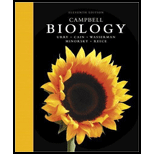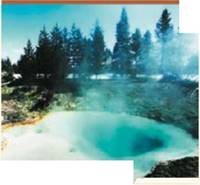
Concept explainers
The water in the Yellowstone National Park hot springs shown here is around 160°F (70°C). Biologists assumed that no species of organismscould live in water above about 130°F(55*C), so thev were surprised to find several species of bacteria there, now called thermophiles
| 15. SYNTHESIZE YOUR KNOWLEDGE |

("heat-lovers"). You've learned in this chapter how an enzyme from one species, Thermus aquaticus, made feasible one of the most important DNA-based techniques used in labs today. ldentify the enzyme, and indicate the value of its being isolated from a thermophile. Suggest other reasons why enzymes from this bacterium (or other therrnophiles) might also be valuable.
Want to see the full answer?
Check out a sample textbook solution
Chapter 20 Solutions
CAMPBELL BIOLOGY-W/MOD.MASTERBIOLOGY
Additional Science Textbook Solutions
Laboratory Manual For Human Anatomy & Physiology
SEELEY'S ANATOMY+PHYSIOLOGY
Biological Science (6th Edition)
Biology: Life on Earth with Physiology (11th Edition)
Campbell Biology in Focus (2nd Edition)
- 3. A promising new drug is being evaluated in human trials. Based on preliminary human tests, this drug is most effective when plasma levels exceed 30 mg/L. Measurements from preliminary tests indicate the following human pharmacokinetic parameter values: t1/2,elim = 4.6hr, t1/2,abs = 0.34hr, VD = 0.29 L/kg, Foral = 72%. Based on these parameters, estimate the following if a 49 kg woman were to receive a 1000mg oral dose of this drug: (a) Estimate the plasma concentration of the drug at 1hr, 6 hr, and 20hr after taking the drug ( Concentration estimate) (b) Estimate the time for maximum plasma concentration (tmax). (c) Estimate the maximum plasma concentration (Cmax). (d) Estimate the time at which the plasma level first rises above 30 mg/L. (Note this is a trial and error problem where you must guess a time, plug it into the concentration equation, and determine if it is close to 30 mg/L. Hint: based on part (a) it should be apparent that the answer is less than 1hr.) (e)…arrow_forwardList substitutions in your diet you could make to improve it based on what you know now about a balanced diet. For instance, if you like to drink soda, you might substitute skim milk or water for some of the soft drinks you consumed. List the item you wish to replace with the new item and what you hope to accomplish with that substitution. Be sure to choose foods you know that you'd enjoy and you consider more "healthful." If you feel your diet is already balanced, describe how you accomplish your balanced intake and when you began eating this way.arrow_forwardWhich single food item contained you ate for the 3 days with the most sodium?arrow_forward
- Select a diet and choose one site that provides credible information. Explain why the source itself and/or the information on the site is credible. This should be a report. This site should be different from U.S News and World Report. For full credit, you must include the following information and elaborate in detail: The diet name The main components of the diet The credible website name and link What makes the credible website credible?arrow_forwardSelect a diet and give a summary of the main components. Do a web search of the diet and choose one link that provides misinformation. Explain why the site itself and/or the information on the site is not credible. This should be a report. This site should be different from U.S News and World Report. For full credit, you must include the following information and elaborate in detail: The diet name The main components of the diet The misinformation website and link What misinformation is being provided in the other website and how did you determine it was not credible?arrow_forward1. In vivo testing provides valuable insight into a drug’s kinetics. Assessing drug kinetics following multiple different routes of administration provides greater insight than just a single route of administration alone. The following data was collected in 250 g rats following bolus iv, oral (po), and intraperitoneal (ip) administration.Using this data and set of graphs, determine: (a) k, C0, V, and AUC* for the bolus iv data (b) k, ka, B1, and AUC* for the po data (c) k, ka, B1, and AUC* for the ip data (d) relative bioavailability for po vs ip, Fpo/Fip (e) absolute po bioavailability, (f)Fpo absolute ip bioavailability, Fip MAKE SURE ANSWERS HAVE UNITS if appropriate. SHOW ALL WORK, including equation used, variables used and each step to your solution.arrow_forward
- 2. Drug quantification from plasma is commonly performed by using techniques such as HPLC or LC/MS. However, these methods do have limitations, and investigators may choose to use a radiolabeled analog of a drug instead. Radioligands are molecules that contain radioactive isotopes, commonly 3H or 14C. This technique allows investigators to quantify drug concentration from radiation measurements. The following measurements were made in 250 g rats following oral administration of 18.2 µCi of a 14C-labeled drug of interest: Time (min) Plasma Radiation Levels (µCi/L) 0 0.0 2 9.7 4 19.2 7 25.3 9 37.8 12 39.6 14 45.8 17 48.8 20 52.0 25 56.4 30 59.2 35 60.1 40 61.1 45 62.1 50 62.8 60 63.1 70 62.1 80 60.1 90 57.3 100 55.5 110 53.7 120 52.2 150 48.0 180 45.0 240 39.0 Note that a µCi is a measure of the amount of radioactivity and hence is a measure of the amount of drug present. Given that the oral bioavailability of this drug is known to be essentially 100%, estimate the following from this…arrow_forwardThe current nutrition labelling regulation in Hong Kong requires food manufacturer to list E+7 information on the package of pre-packaged food products. Do you think that more nutrients, such as calcium and cholesterol, shall be included?arrow_forwardView History Bookmarks Window Help Quarter cements ents ons (17) YouTube Which amino acids would you expect to find marked on the alpha helix? canvas.ucsc.edu ucsc Complaint and Grievance Process - Academic Personnel pach orations | | | | | | | | | | | | | | | | 000000 000000000 | | | | | | | | | | | | | | | | | | | | | | 00000000 scope vious De 48 12.415 KATPM FEB 3 F1 F2 80 F3 a F4 F5 2 # 3 $ 85 % tv N A の Mon Feb 3 10:24 PM Lipid bilayer Submit Assignment Next > ZOOM < Å DII 8 བ བ F6 16 F7 F8 F9 F10 34 F11 F12 & * ( 6 7 8 9 0 + 11 WERTY U { 0 } P deletearrow_forward
- Different species or organisms research for ecologyarrow_forwardWhat is the result of the following gram stain: positive ○ capsulated ○ acid-fast ○ negativearrow_forwardWhat type of stain is the image below: capsule stain endospore stain gram stain negative stain ASM MicrobeLibrary.org Keplingerarrow_forward
 Biology Today and Tomorrow without Physiology (Mi...BiologyISBN:9781305117396Author:Cecie Starr, Christine Evers, Lisa StarrPublisher:Cengage Learning
Biology Today and Tomorrow without Physiology (Mi...BiologyISBN:9781305117396Author:Cecie Starr, Christine Evers, Lisa StarrPublisher:Cengage Learning BiochemistryBiochemistryISBN:9781305577206Author:Reginald H. Garrett, Charles M. GrishamPublisher:Cengage Learning
BiochemistryBiochemistryISBN:9781305577206Author:Reginald H. Garrett, Charles M. GrishamPublisher:Cengage Learning
 Biology 2eBiologyISBN:9781947172517Author:Matthew Douglas, Jung Choi, Mary Ann ClarkPublisher:OpenStax
Biology 2eBiologyISBN:9781947172517Author:Matthew Douglas, Jung Choi, Mary Ann ClarkPublisher:OpenStax





